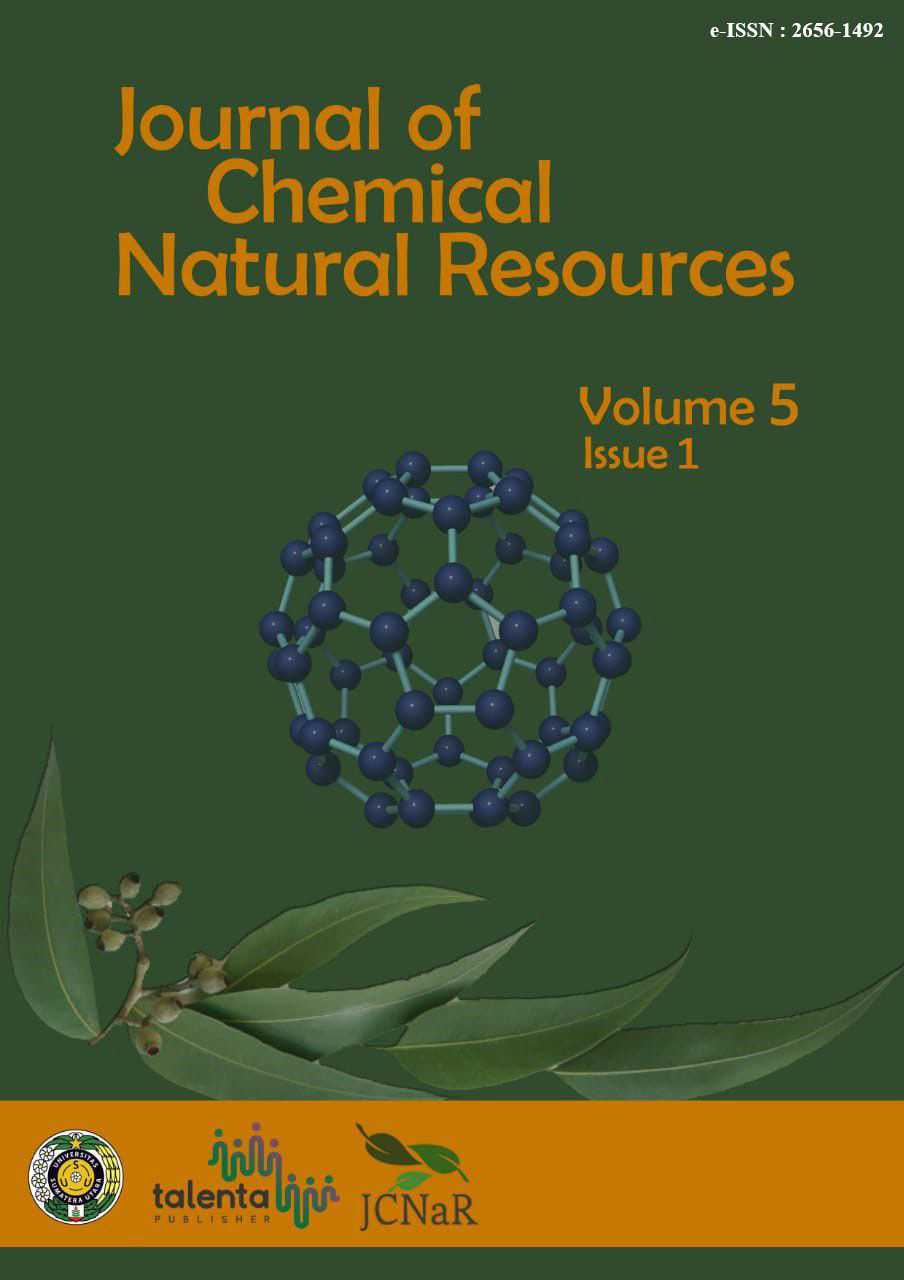Effect of Addition of Oleic Acid as a Template with Tetraethylorthosilicate (TEOS) as Source of Silica on Porosity Mesoporous Silica Material
DOI:
https://doi.org/10.32734/jcnar.v5i1.11993Keywords:
APMS, Oleic Acid, Silica Mesoporous Material, Templates, TEOSAbstract
Mesoporous silica material has been synthesized using tetraethylorthosilicate (TEOS) as a source of silica, oleic acid as a template, and 3-aminopropyltrimethoxysilane (APMS) as co-structure directing agents (CSDA). The synthesis of silica material was made with a variation in the mole ratio of TEOS: Oleic acid with a ratio of 1: 0.2; 1: 0.3; 1: 0.5; 1: 0.6; 1: 0.7; 1: 0.9, and 1: 1. A mixture between TEOS and APMS was added to a mixture of oleic acid, HCl 0.1N and demineralized water then stirred at room temperature for 2 hours. Then aging, the mix at 80oC for 48 hours until solids are formed. Product separation was used in the centrifugation method. The resulting solid was dried at 50oC, and to remove the template, calcined at 550oC for 6 hours. The product of XRD analysis has a wider diffraction peak that indicates an amorphous material. The FT-IR spectrum shows the Si-OH and Si-O-Si groups which area characteristic of silica material. The product of SEM analysis offers the presence of sheets and plates of particle forms with different sizes. Adsorption desorption isotherm (BET) shows an isotherm type IV curve, and dominant pore sizes are 1.945 and 4.588 nm.
Downloads
References
Vansant, E. F., P. Van Der Voort., and K.C. Vrancken., 1995. Characterization and Chemical Modification of The Silica Surface, Elsevier.
Wang, X., Miao, X-R., Li, Z-M., and Deng, W-L., 2011. Febrication of Microporous Hollow Silica Sphere Templated by NP-10 Micelles without Calcination. Apllied Surface Science, 257, 2481-2488.
Schubert, U., and Husing, N., 2005. Synthesis of Inorganic Materials, Second Edition, Revised and Updeted Edition, Wiley-VCH Verlag GmbH & Co, KgoA, Weinheim, 308-309.
Kleitz, F., Shin Hei Choi., and Ryong Ryoo., 2003. Cubic Ia3d large mesoporous silica : synthesis and replication to platinum nanowires, carbon nanorods and carbon nanotubes. ChemComm. UK.
Khodakov, A., Vladimir Zholobenko., Rafeh Bechara., and Dominique Durand., 2005. Impact of aqueous impregnation on the long-range ordering and mesoporous structur of cobalt containing MCM-41 and SBA-15 materials. Elsevier Science., 79, 29-39.
Zhao, D., Huo, Q., Feng, J., Kim, J., Han, Y., and Stucky, G. D., 1999. Novel Mesoporous Silicates with Two-Dimensional Mesostructure Direction Using Rigid Bolaform Surfactants. Chem. Meter., 11 (10), 2668-2672.
Yokoi, T., Hideaki Yoshitake., and Takashi Tatsumi., 2003. Synthesis of Anionic-Surfactant-Templated Mesoporous Silica Using Organoalkoxysilane-Containing Amino Groups. American Chemical Society.
Gracia-Bennett, A., Natalia Kupferschmidt., Yasuhiro Sakamto., Shunai Che., and Osamu Terasaki., 2005. Synthesis of Mesocage Structures by Kinetic Control of Self-Assembly in Anionic Surfactants. Wiley-VCH Verlag GmbH & Co. KgaA, Weinheim. 44, 5317-5322.
Wang, J.G., Xiao, Q., Zhou, H.J., Sun, P.C., Ding, D.T., and Chen, T.H., 2008. Anionic Surfactant-Templated Mesoporous Silica (AMS) Nano-Spheres with Radially Oriented Mesopores. J. Colloid and Interface Science, 323,332-337.
Andriayani., 2012. Sintesis Material Mesopori Silika Dari Tetraetilortosilikat (TEOS) Menggunakan Natrium Risinoleat Sebagai Template Dan 3-Aminopropiltrimetoksisilana (APMS) Sebagai Co-Structure Directing Agent (CSDA). Disertasi Universitas Sumatera Utara. Medan.
Andriayani., Seri Bima Sembiring., Nida Aksara., and Nofrijon Sofyan., 2013. Synthesis of Mesoporous Silica from Tetraethylorthosilicate by Using Sodium Ricinoleat as a Template and 3-Aminopropyltrimethoxysilane as Co-Structure Directing Agent with Volume Variation of Hydrochloric Acid 0,1M. Advanced Materials Research Vol. 789 pp 124-131. Trans Tech Publications. Swizerland.
Pang, J.B., Qiu, K.Y. and Wei, Y., 2001. J. Non-Cryst. Solids, 283, 101-108.
Shinya,Y., 2014. Effect of Oleic Acid Addition on Crystallinity of Mesoporous Calscium Carbonate. Transactions of JWRI, Vol. 43 . No. 2.
Zhao, Q., Zhuo, X., Ji, M., Ding, H., Jiang, T., Li, C., and Yin, H., 2011. Stability and Textural Properties of Cobalt Incoporated MCM-48 Mesoporous Molecular Sieve. Applaid surface Science, 257, 2436-2442.
Deshmukh, P., Jatin Bhatt., and Dilip Peshwe., 2011. Determination of Silica Activity Index and XRD, SEM and EDS Studies pf Amorphous SiO2 Extracted from Rice Husk Ash, Springer, India.
Thommes, M., Katsumi Kaneko., Alexander V. Neimark., James P. Olivier., Francisco Rodrigues-Reinoso., Jean Rouquerol and Kenneth S.W. Sing., 2015. Physisorption of Gases, With Special Reference to the Evaluation of Surface Area and Pore Size Distribution (IUPAC Technical Report), De Gruyter.
Dipoewardani, B., Sriatun., Taslimah., 2008. Sintesis Silika Kristalin Menggunakan Surfaktan Cetiltrimetilamonium Bromida (CTAB) dan Trimetilamonium Klorida (TMACl) sebagai Pencetak Pori. Universitas Diponegoro.

Downloads
Published
Issue
Section
License
Copyright (c) 2023 Journal of Chemical Natural Resources

This work is licensed under a Creative Commons Attribution-ShareAlike 4.0 International License.














